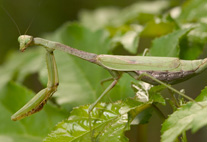Abstract
Stagmomantis is a remarkable genus within the Mantodea, being relatively species-rich and geographically widespread. Yet, the number of species within the genus remains curiously unresolved. The present synoptic review surveys the literature on Stagmomantis to identify named species for which scientific consensus exists, as well as to summarize basic biological information for each species, including geographic distribution, morphological features, and sex-specific biometric data. The review identifies 23 consensus taxa within Stagmomantis: 22 separate species, with one of these species, S. montana, split into two subspecies (S. m. montana and S. m. sinaloae). The review indicates morphological features that may prove to be diagnostic for a given species, particularly when examined in conjunction with male genitalia. Such features include dark spots on the anterior femur (S. amazonica, S. centralis, S. marginata, S. nahua, S. venusta, S. vicina), spines or denticulations on the anterior coxa (S. colorata, S. montana montana, S. parvidentata, S. theophila), and dark bands on abdominal tergites (S. californica, S. colorata, S. domingensis). Color variation of certain features with respect to body coloration, such as stigma coloration and body and leg markings, requires more attention. Information on life history, reproduction, and ecology are summarized, particularly for temperate populations of S. carolina and S. limbata. While the 23 consensus taxa represent a robust appraisal of the existing literature, some taxonomic uncertainties remain. The status of two species are somewhat unclear (S. marginata and S. tolteca), calling for taxonomic evaluation. Furthermore, proposed within-genus groupings deserve examination, as do possible subdivisions within some species (e.g., S. limbata, S. parvidentata). Information on basic morphology and biometry remains incomplete for nearly all species. Extreme examples are S. amazonica, S. costalis, and S. paraensis, for which females have not been described. Live animal research on life history, behavior, and ecology is needed for all species, with the possible exceptions of S. carolina and S. limbata. By reconciling species assignments and consolidating biological information for the 23 consensus taxa, this synoptic review promises to guide subsequent systematic and phylogenetic investigations of the genus Stagmomantis.

